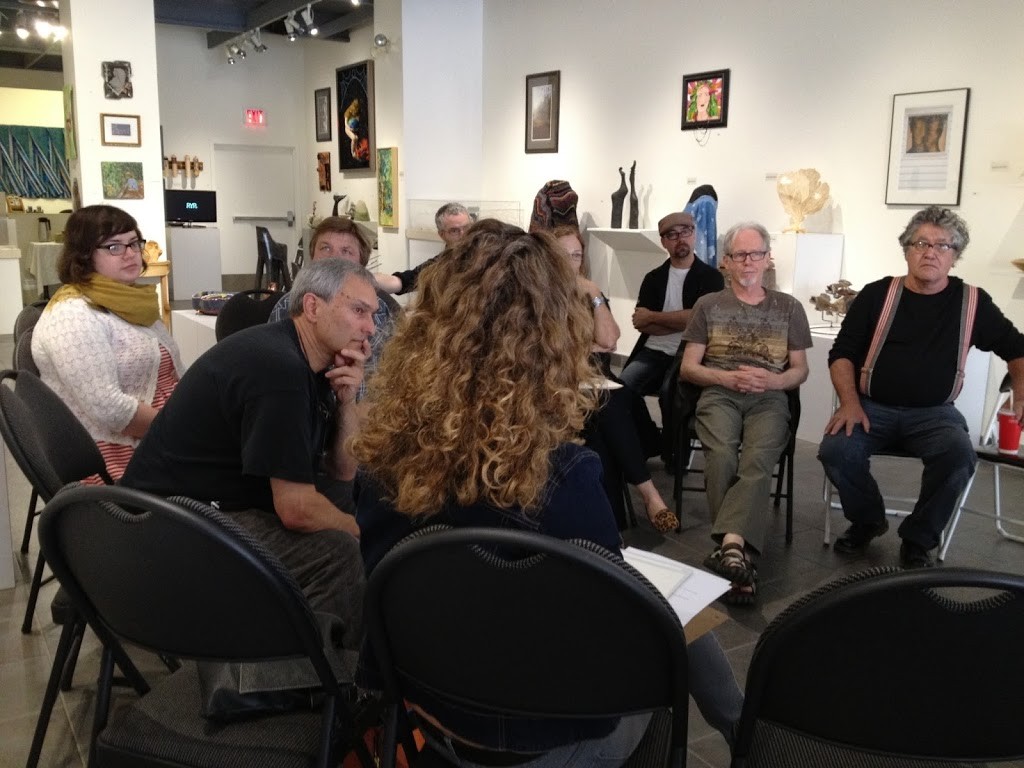Written by: Leslie Potter, Exhibitions and Education Coordinator
“Has technology changed or eradicated the ‘craft’ of photography?”

A round table discussion in Affinity Gallery in 2013.
As a part of our current gallery exhibition Photographic Phantasmagoria, a compelling Round Table Discourse about this question will be held at 2 pm on Saturday, February 20 in Affinity Gallery. Anyone interested in photography, technology, craft, or the topic in general is welcome to this free discussion. Quietly listen or jump up and down in excitement; this will be a casual conversation among the curious, the thoughtful, the digital converts, and the analogue die-hards. RSVP on Facebook.
![]() The proclivity we have to create and record has led us to a place in our evolution where not only can we document anything instantly, but we can also change that information instantly. We are able to bend, distort, colour and shape any image that we produce. And, we can do any or all of this with a push of a button. This brings us to the question of this exhibition: When does technology start to distort the definition of craft? The answer, I believe, is that it is still a work in progress, not yet definitive, and somewhat phantasmagorical itself. How it is resolved will depend on who participates.
The proclivity we have to create and record has led us to a place in our evolution where not only can we document anything instantly, but we can also change that information instantly. We are able to bend, distort, colour and shape any image that we produce. And, we can do any or all of this with a push of a button. This brings us to the question of this exhibition: When does technology start to distort the definition of craft? The answer, I believe, is that it is still a work in progress, not yet definitive, and somewhat phantasmagorical itself. How it is resolved will depend on who participates.
—
Photographic Phantasmagoria features contemporary photos by 24 different photographers from across Canada. Some of these artists used the simplest methods of photography — light and chemical reaction. Others pieces were created with historical techniques like wet plate collodion (19th century). A variety of formats — from a large scale panorama to 3D printing — are represented. Images were created with salt, carbon, coffee, without cameras (photograms), without lenses (pinhole cameras), and using video technology.
This exhibition also showcases photographic equipment used through the ages. Visitors will see an 1870s field camera, the first polaroid camera, and a Russian sniper camera. There are handmade/customized pieces including a scanning digital camera, a modified globuscope, plus a working camera obscura. A 3D printer, scanner, and objects are also on display.
Background:

“Photographic Phantasmagoria” in Affinity Gallery.
At its inception, the SCC took quite a “purist” view on what constituted craft. For example, in 1980 a woven piece was deemed ineligible to be considered in Dimensions jurying because the borders were stitched with the assistance of a sewing machine. From that beginning, the SCC has developed a more “inclusive” operational definition of craft than other craft councils in Canada. In the mid-1980s, printmaking and photography were deemed to be craft media by the SCC. In the case of photography, the SCC is the only provincial craft council with this view.
In 2004, the SCC Board defined craft as “an artistic endeavor characterized by the creation, with skill and by hand, of three-dimensional work that is rooted in, but may transform, transcend or maintain the traditions and materials of the utilitarian object.” In 2011, this was modified by dropping the term “three-dimensional”, as it was creating problems in dealing with printmaking and photography.
“Craft” has been defined in many ways, but these definitions usually include some element of:
- Craft production is seen as arising from the production of functional objects that contain a significant aesthetic component;
- Craft is produced “by hand”. In practice that means produced with the aid of tools rather than with machines, and that there is a unity between the conceiver and maker;
- Craft tradition views excellence in technique and material as being of central importance;
- In some, but not all definitions of craft, three-dimensionality is deemed to be of importance. In other words, craft makers produce objects.
Technology and photography go hand in hand, always have. But photographic technology has mushroomed and our capabilities as “photographers” have changed considerably in the past two decades. Perhaps we need to ask ourselves if we need a definition of craft – if makers show competence, dexterity, expression, skill and content in their work, would that be enough? What is the difference between using a hand saw to cut a piece of wood and using a mouse for design purposes?
I will let Peter Adams have the last words, “Photography is not about cameras, gadgets and gismos. Photography is about photographers. A camera didn’t make a great picture any more than a typewriter wrote a great novel.”
